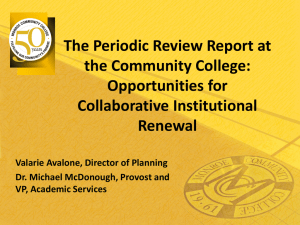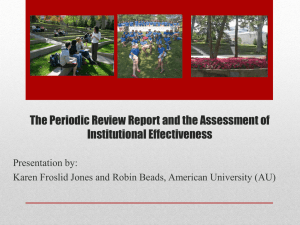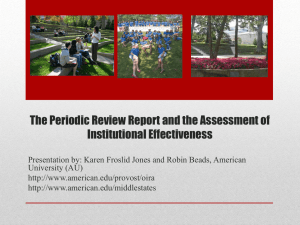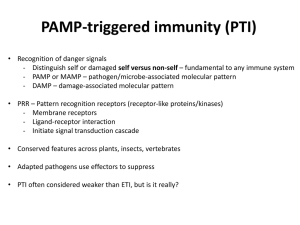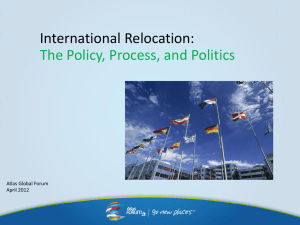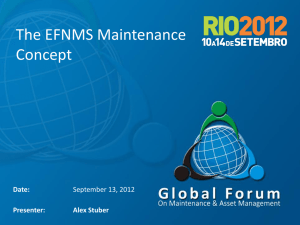pptx - Ann Gordon-Ross - University of Florida
advertisement
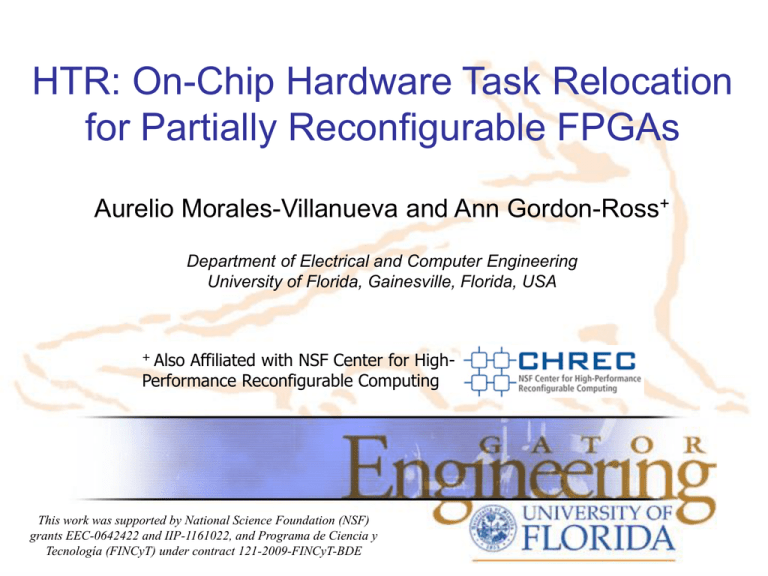
HTR: On-Chip Hardware Task Relocation for Partially Reconfigurable FPGAs Aurelio Morales-Villanueva and Ann Gordon-Ross+ Department of Electrical and Computer Engineering University of Florida, Gainesville, Florida, USA Also Affiliated with NSF Center for HighPerformance Reconfigurable Computing + This work was supported by National Science Foundation (NSF) grants EEC-0642422 and IIP-1161022, and Programa de Ciencia y Tecnología (FINCyT) under contract 121-2009-FINCyT-BDE Introduction • Multitasking in modern systems – Software tasks: implemented in microprocessors – Hardware tasks: implemented in field-programmable gate arrays (FPGAs) • Task management requirements in any multitasking system – Task scheduling • Mechanism to begin task execution on a system resource – Task suspension • Preempt task and saving execution state --- context save (CS) – Task switching • Replacing preempted task with another task – Task restoration • Resume preempted task from saved state --- context restore (CR) Task Task Task A B C A B C A T1 T2 T3 T4 T5 T6 time B T1 T’2 T3 T’4 T5 T’6 time T1 T’2 T3 T’4 T7 time 2 of 18 Context Switching Analogy Processor Context Switch FPGA Context Switch uP FPGA Software task 1 Software task 2 uP or custom HW Stack OS + MMU Region 1 Hardware task 1 Region 2 Hardware task 2 Region 3 Hardware task N Software task N • One task executes at a time – Time multiplex tasks • One stack for all tasks – Stack saves context for task restore • No task relocation • No reconfiguration of uP • Multiple tasks execute concurrently • Multiple regions time multiplex tasks – Use context save and context restore for task switching • Task relocation – Challenging! • Leveraging partial reconfiguration can be advantageous… 3 of 18 Reconfiguration on FPGAs • Benefits to system designers and functionality – Run-time hardware adaptation via time multiplexing of resources – Reduced area/power requirements – Two types of reconfiguration: Full and partial reconfiguration • Full reconfiguration: – Entire FPGA configured with full bitstream with fixed hardware task set – Reconfiguration halts all tasks --- lengthy task switching time – No context save/restore of hardware tasks --- tasks restart execution HW task A1 A2 HW task B1 B2 C2 HW task C1 Full bitstream 1 Configuration Port Full bitstream 2 Execution and state of all tasks is lost during full reconfiguration! 4 of 18 Partial Reconfiguration (PR) • PR divides the FPGA fabric into two regions – Static region: fixed functionality, never reconfigured after initial configuration at startup – Reconfigurable region: multiple PR regions (PRRs) Embedded processor Mem Controller ICAP Module A Module B Module C Module D • PRRs execute PR modules (PRMs) (hardware tasks) Static region • PR compared to full reconfiguration Reconfig. region – Dynamic, on-the-fly PR of individual PRRs • No interruption of static region or other PRRs! – Uses partial bitstreams --- smaller than full bitstreams – Increased flexibility – Increased task throughput/performance – Enhances hardware multitasking • Requires context save and context restore for effective task switching Function • Faster reconfiguration time • *May* require a bitstream for each PRM-to-PRR mapping Configuration Overhead Reconfiguration Overhead Static region operation Power On Time 5 of 18 Previous Related Work • Context save and restore (CSR) Over the same PRR using: • Off-chip CSR software – Requires external host (e.g., CPU) – Lengthy communication overhead • On-chip CSR hardware – Device overhead, limited portability reconfigure context restore context save task’s context custom HW custom PRMs + No task re-execution after context restore • Bitstream relocation (BR) + Eliminates per-PRR bitstream requirement Off/on-chip BR over homogeneous PRRs • Same shape/resources, different FPGA fabric locations - Does not save/restore task’s context • Re-execution of relocated task required homogeneous PRRs reconfigure reconfigure relocate + reconfigure PRMs – No relocation over heterogeneous PRRs 6 of 18 Motivations • Improvements over off-chip context save and restore (CSR) software – Eliminate external host requirement --- autonomous – Eliminate communication overhead between FPGA and external host • Improvements over on-chip context save and restore (CSR) hardware – Eliminate custom hardware requirement and area overhead – Eliminate portability limitations • Improvements over bitstream relocation (BR) – Enable task relocation over heterogeneous PRRs – Eliminate task re-execution requirement 7 of 18 Contributions • On-chip hardware task relocation (HTR) software – Relocation of hardware tasks over heterogeneous PRRs • PRRs with different shape, resources, locations on the FPGA fabric – Relocation of hardware task context • Task’s execution state is preserved --- no re-execution • HTR benefits – Maximizes shared resources utilization • Reduces idle PRRs --- PRMs can run in any available PRR* – Maximizes task throughput • Improves task scheduling performance • Preemption and resumption of tasks in different PRRs – Priority considerations • Eliminates lengthy re-execution time of relocated preempted tasks * Some restrictions apply, but are addressed in our current/future work 8 of 18 Hardware Task Relocation (HTR) 9 of 18 HTR Operation Resume Operation • Main HTR software steps Task M1 M2 region – Initialize static and PRRs Relocation PRR1 PRR1 Resume • Initial configuration of tasks in all PRRs Operation – Context save (CS) Task Still Busy Relocation •M5Save theM4 execution state of the preempted hardware task Still Busy PRR2 PRR2 – Task relocation (TR) Context • Generation of a “merged bitstream” of relocated task Save – Use Context restore (CR) M3 M5 initial PRR3 PRR3 partial•bitstream Resume execution of preempted task in another PRR Context Restore M2 PRR4 M6 Use initial PRR4 partial bitstream Context Restore 10 of 18 HTR Flow Chart Example system PRM 1 PRM 2 Reconfiguration of PRR1 with PRM1 Treconfig_PRR Enable FPGA protection Tprotect_FPGA Initialization Initial conditions Executing PMR3 PRR1 PRR2 PRM2 executed in PRR1 and saved the context Context save and restore (CSR) PRM PRM 2 2 PRM 3 Y PRR1 free or priority PRM N N Hardware task relocation (HTR) of PRM2 on PRR2 TCS2 TCS1 Context save of PRM1 Context save of PRM3 Tmerge Merge saved context of PRM2 with initial bitstream of PRM2 Saved context relocation of PRM2 in PRR2 Trelocate Context restore of PRM2 on PRR1 Context restore of PRM2 on PRR2 TCR2 Execute PRM2 on PRR1 Execute PRM2 on PRR2 TCR1 Merged Execute PRM2 Y 11 of 18 Experimental Results Experimental Setup • Virtex-5 LX110T on Xilinx ML509 board • Two reconfigurable regions (PRRs) – Contain configurable logic block (CLB) resources (flip-flops) – Heterogeneous sizes and FPGA fabric locations • Task relocation cases – – – – – Small-to-large PRR task relocation Large-to-small PRR task relocation Source PRR = PRR with task’s saved context Destination PRR = PRR with task’s relocated context Restrict test cases for tractability • Large PRR = 2x number of columns and frames of small PRR • Number of flip-flops used by the task are the same for all PRR sizes 13 of 18 Results – Context Save (TCS) (per column) • Context save time shows linear growth rate • Dependent on the number of PRM frames in the source PRR 14 of 18 Results – Task Relocation (Trelocate) (per column) • Task relocation time shows non-linear growth rate – Random access pattern to saved context and merged bitstreams – High data cache misses and overheads accessing data from SDRAM • Dependent on the number of PRM flip-flops to be relocated 15 of 18 Results – Context Restore (TCR) (per column) • Context restore time shows nearly linear growth rate • Dependent on the number PRR frames in the merged bitstream (destination PRR) • Context restore time is larger than PRR reconfiguration time (Treconfig_PRR) – Unprotection and protection of destination PRR 16 of 18 Conclusions • Introduced on-chip hardware task relocation (HTR) software – Task relocation between heterogeneous PRRs • Maximizes shared resource utilization – – – – No off-chip communication overhead No design/system constraints Application/system independent Aids system design • Detailed descriptions entended for designer use • Analysis enables designers to tradeoff HTR execution times and task/PRR granularity • Future work – Extend HTR’s functionalities • Include DSP, BRAM, and IOB resources in PRRs 17 of 18 Questions? 18 of 18
